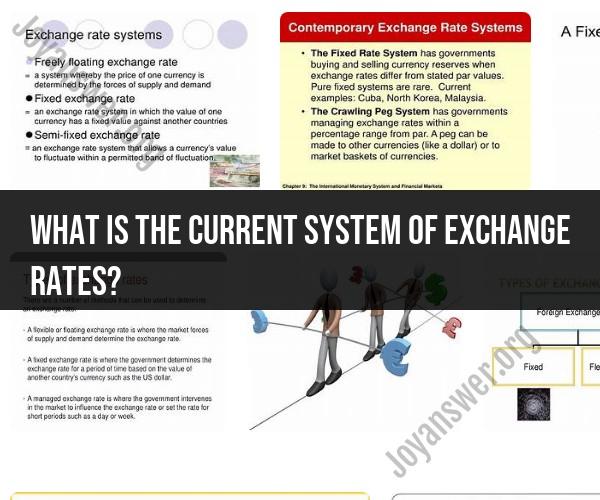What is the current system of exchange rates?
The current system of exchange rates is characterized by a combination of fixed, floating, and managed exchange rate systems. Exchange rates refer to the value of one country's currency in terms of another currency. These rates can fluctuate due to various factors, including economic conditions, government policies, and market forces. Here's an overview of the current system of exchange rates:
Floating Exchange Rates: Many major currencies, including the U.S. dollar (USD), euro (EUR), Japanese yen (JPY), and British pound (GBP), have floating exchange rates. In a floating exchange rate system, currency values are determined by the foreign exchange market based on supply and demand. Central banks may intervene occasionally to stabilize or influence their currency's value, but, for the most part, rates fluctuate freely.
Fixed Exchange Rates: Some countries maintain fixed exchange rates. This means their currency's value is pegged to another currency or a basket of currencies. The pegged rate is set and maintained by the country's central bank or government. For example, the Chinese yuan (CNY) is managed through a fixed exchange rate system. However, even in these systems, central banks may adjust the peg over time to reflect economic conditions.
Managed or Dirty Float: In a managed or dirty float system, exchange rates are nominally floating, but central banks or governments intervene in currency markets to influence their value. They do this by buying or selling their currency to stabilize or influence its exchange rate. Some countries, like Switzerland, employ this system to prevent extreme fluctuations in their currency value.
Crawling Peg or Adjustable Peg: In a crawling peg system, a country's exchange rate is pegged to another currency, but the peg is adjusted periodically. The adjustments are typically tied to economic indicators or a pre-determined formula. This system allows for more flexibility than a fixed exchange rate.
Currency Blocs: Some countries participate in currency blocs where multiple nations use a common currency or manage their currencies within a specific range. The most notable example is the Eurozone, where the euro (EUR) is used by 19 of the 27 European Union member states. These countries share a common monetary policy under the European Central Bank.
Currency Interventions: Central banks and governments may periodically intervene in currency markets to stabilize their currency's value or respond to economic conditions. They can buy or sell their currency to influence exchange rates.
It's important to note that exchange rates are influenced by various factors, including interest rates, inflation, economic growth, geopolitical events, and market sentiment. In a globalized economy, exchange rates play a crucial role in international trade and financial markets, impacting businesses, investors, and individuals.
Exchange rates can fluctuate daily, and it's essential to monitor rates and consider the current economic and political climate when conducting currency transactions or investment decisions. Additionally, while the systems described above are the most common, some countries may have unique exchange rate arrangements or use a combination of these systems.
The Current System of Exchange Rates: An Overview
The current system of exchange rates is a managed floating exchange rate system. This means that governments and central banks intervene in the foreign exchange market to influence exchange rates, but they do not allow them to float freely.
Governments and central banks intervene in the foreign exchange market by buying and selling currencies. When a government buys its own currency, it is appreciating the currency. When a government sells its own currency, it is depreciating the currency.
Governments and central banks intervene in the foreign exchange market for a variety of reasons, including:
- To promote economic growth: A strong currency can make exports more expensive and imports cheaper, which can hurt economic growth. Governments may intervene in the foreign exchange market to weaken their currency and boost exports.
- To protect domestic industries: Governments may intervene in the foreign exchange market to protect domestic industries from foreign competition. For example, a government may intervene to weaken its currency and make imports more expensive.
- To maintain financial stability: A sharp depreciation in a currency can lead to financial instability. Governments may intervene in the foreign exchange market to support their currency and prevent a financial crisis.
Fixed vs. Floating Exchange Rate Systems
A fixed exchange rate system is a system in which the government fixes the value of its currency relative to another currency or a basket of currencies. A floating exchange rate system is a system in which the value of the currency is determined by the forces of supply and demand in the foreign exchange market.
Fixed exchange rate systems were more common in the past, but today most countries use a managed floating exchange rate system. Fixed exchange rate systems can be difficult to maintain, especially for countries with small economies. If the economy weakens, the government may be forced to devalue its currency, which can lead to inflation and financial instability.
Exchange Rate Mechanisms and Their Significance
Exchange rate mechanisms are frameworks that governments use to manage their currencies. Some common exchange rate mechanisms include:
- The target zone: A target zone is a range of values within which the government allows its currency to fluctuate. If the currency moves outside of the target zone, the government will intervene to bring it back into the target zone.
- The crawling peg: A crawling peg is a system in which the government adjusts the value of its currency by a small amount each day or week. This system is often used to gradually depreciate the currency.
- The managed float: A managed float is a system in which the government intervenes in the foreign exchange market to influence the value of its currency, but it does not allow it to float freely. This is the most common exchange rate mechanism in use today.
Exchange rate mechanisms are significant because they can have a major impact on the economy. A government's choice of exchange rate mechanism can affect economic growth, inflation, and financial stability.
International Agreements and Exchange Rate Stability
There are a number of international agreements that are designed to promote exchange rate stability. One of the most important agreements is the Bretton Woods Agreement, which was established in 1944. The Bretton Woods Agreement created the International Monetary Fund (IMF) and the World Bank. The IMF is responsible for promoting international financial stability and cooperation. The World Bank provides loans and financial assistance to developing countries.
Another important international agreement is the General Agreement on Tariffs and Trade (GATT), which was established in 1947. The GATT was replaced by the World Trade Organization (WTO) in 1995. The WTO is responsible for promoting free trade and international economic cooperation.
International agreements can help to promote exchange rate stability by reducing trade barriers and increasing cooperation between countries. When countries have strong economic ties, they are less likely to engage in competitive devaluations, which can lead to exchange rate instability.
Trends and Developments in the Global Exchange Rate System
The global exchange rate system has evolved over time. In the past, most countries used fixed exchange rate systems. However, today most countries use a managed floating exchange rate system.
One of the most significant trends in the global exchange rate system is the rise of the US dollar as the world's reserve currency. The US dollar is the most widely traded currency in the world and is used as a benchmark for many other currencies.
Another significant trend in the global exchange rate system is the increasing integration of financial markets. This integration has made it more difficult for governments to manage their currencies.
The global exchange rate system is likely to continue to evolve in the future. It is important to monitor developments in the global exchange rate system, as they can have a major impact on the economy.











